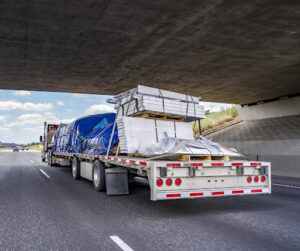Trucking technology trends: Top 5 collision prevention tools
- May 23, 2023
- By Gerard Devita

With truck accidents rapidly increasing year after year, now more than ever, there’s a need for new trucking technology to help keep the roads safe. There are countless trucking technology trends these days, a virtually endless list of tools and aids that can be added to CMVs. Some of these technologies will become obsolete within a few years.

Top 5 collision prevention tools
Others will become tried and true and prove worth the investment of the time and money it takes to install the new technology in a fleet of trucks. Here are five collision prevention tools that can be implemented on commercial trucks, which are worth the effort and expense now and in the foreseeable future:
1. Dynamic routing
Dynamic routing uses navigation to send truck drivers on the fastest routes to their destinations, and provides nearly real-time updates to the route based on traffic and weather conditions. This proves invaluable for truck companies and drivers because it saves them time and money by getting the products to their destination faster.
However, it can also help reduce accidents. Dynamic routing informs truck drivers of poor traffic or weather conditions on their route, then reroutes them to a better path. Heavy traffic and bad weather make accidents more likely for trucks just like they do for passenger vehicles, but with trucks, the accidents can be much worse because of their size and weight. If a truck is rerouted to roads with less traffic, there is a lower risk of accident.
2. Forward-looking cameras
Another trucking technology that can help prevent accidents is forward-looking cameras. Cameras have been installed on trucks for several years now, but are becoming even more common. Their purpose is to record what’s happening at the time of an accident, in the hopes of proving who was at fault.
They can also record the driver and identify dangerous behaviors such as cell phone usage and signs of driver fatigue. SmartDrive is a company focusing on a type of camera that can detect signs of distracted driving. This holds drivers accountable and helps reduce distracted driving, which can lead to accidents. Cameras can also notify truck drivers when there is another vehicle in their blind spot, making it safer to make turns and change lanes.
3. Trailer tracking
Trailer tracking is a trucking technology that allows trucking companies to keep track of where their trailers are so that they can track their assets. But along with its physical location, trailer tracking can also help track maintenance data, enabling employees to log what parts of the truck have had maintenance checks or service performed.
With a large number of trucks in a fleet, it can be difficult to keep track of which trucks are behind on maintenance, and puts a lot of responsibility on the truck drivers to keep up with maintenance data. Tracking the data electronically allows truck fleet managers to keep tabs on what trucks need to be serviced, which keeps the trucks in safer driving condition.

4. Electronic stability control
Electronic stability control is a trucking technology that helps to prevent trucks from tipping over on the road. This technology will automatically be activated when the truck is going too fast or turning too sharply and apply the brakes. Overturned trucks can cause horrific fatal accidents, so this one small safeguard can help keep the driver and everyone else on the road safe by detecting turnover risk and preventing it.
5. Artificial intelligence-powered fleet and staff management
Artificial intelligence (AI) may sound futuristic, but it’s actually fairly common and ready to use. AI-powered management of truck fleets and drivers can be a huge help for road safety. Artificial intelligence can analyze data taken from drivers and trucks across the entire fleet and identify which drivers pose safety risks, and which trucks have potential safety issues.
AI can detect those drivers who fail to meet safety protocols so they can be pulled from service for additional training and coaching. This holds truck drivers accountable and gives them the professional training they need to do their jobs in a safer, more effective way. When truck drivers are following all the necessary safety protocols, the roads are a safer place, and there is a lower risk of truck accidents.
Technology continues to evolve, but basic road safety is still important
Trucking technology is evolving at a rapid rate, making trucks smarter and safer than ever before. Unfortunately, truck accidents and fatalities are also increasing at a rapid rate, so we cannot rely on technology alone to keep our roads safe.
Now more than ever, it’s crucial that drivers do their best to be safe while on the roads. For truckers, that means getting the required amount of rest between shifts, staying alert, avoiding distractions while driving, keeping up with truck maintenance to ensure a safe and functioning vehicle, and carefully following safety standards and protocols to keep themselves and everyone else on the road protected.
Even in the midst of groundbreaking advances in trucking technology, truckers must still do their part to drive cautiously and prevent wrecks.
Injured in a truck accident? We can help.
Trucking companies and truck drivers are doing their best to lower the rates of truck accidents, but the crashes are still happening. If you’re injured in a truck accident, we can help. If you didn’t cause the accident, you shouldn’t be responsible for the costs associated with it.
At Carner & DeVita, we’re here to stand up for you and bring justice to your case after you’re injured. Call (631) 543-7070 today to schedule a free consultation with a Suffolk County truck accident lawyer. We’ll go over your case together, so you can decide the best course of action moving forward.
Have question?
Contact us today!
